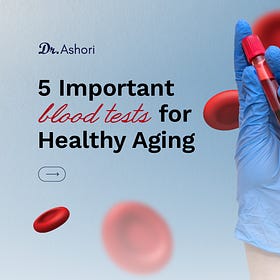Spotting Insulin Resistance Without Lab Tests
Try these "tests" to know whether you have any insulin problems. The body often signals insulin trouble years before blood tests confirm it.
UPDATED: July 22nd, 2025
Welcome to the Healthy Aging Newsletter, a free publication translating trustworthy medical research into simple habits to age well, free of chronic disease. I’m Dr. Ashori, a family medicine doctor turned health coach.
As a physician I rely heavily on advanced testing to confirm my clinical hypothesis. But before I put my patients through the pain and expense of any tests, we go with high-probability observations when considering a condition, such as insulin resistance.
Insulin resistance isn’t just about developing type 2 diabetes in the future, it also affects tissue healing, inflammation, cancer and dementia risk, and heart and liver disease.
1. The Mirror Check
It’s important to me to help my patients develop a comfort of looking at themselves naked in the mirror. It’s much harder than you think. But it’s very revealing when done without judgement and love and respect for the physical being staring back at us.
Belly larger than hips
Waist (measured at belly button) to height ratio > 0.5
BMI > 30
Dark velvety patches around the neck, armpits, and/or thighs
Clusters of skin tags in the same areas
Thinning hair at the crown in women
Extra facial hair in women, especially the chin
Puffy face or ankle swelling that eases up overnight
Not being able to see some muscle definition in the extremities
2. How You Feel Day to Day
Heavy sleepiness after meals, especially heavy meals
Brain fog after carb-heavy meals
Strong craving for high-sugar content foods
Sudden energy bursts followed by crashes
Tough time recovering after moderate exercise
Poor stamina with mild or moderate activities
4. Dietary Pattern Clues
Calorie dense foods at every meal (cheese, ketchup, chips, mayo, sweet sauces)
Daily sugar-sweetened beverages
Daily moderate sugar consumption
2-3 alcoholic beverages daily
Frequent ultraprocessed food consumption (packaged snacks, white bread, noodles)
Low vegetable or lean protein intake
Heavy salt intake with most meals
5. Lifestyle Clues
Highly sedentary life with minimal activity levels in the week
Sleeping < 6 hours per night
Poor sleep quality without feeling rested most days
High stress without adequate stress relief or coping
Busy life with very little downtime
Simple Daily Interventions to Reverse Insulin Resistance
The good news is that the body is dead-set on reversing insulin resistance and it knows how to do it. It takes a hefty effort on our part but if given the opportunity, your body knows what to do.
Start with 30 minute daily walks
Attempt some resistance work daily, feelings leg and arms muscles contract
Build meals around lean proteins and healthy fats and unprocessed carbs
Cut sugary and ultraprocessed packaged foods as much as possible
Spend more time listening to music, socializing with friends, reading
Switch from soda to carbonated water
Sneak out a little sauce from your meals whenever possible
Eat out at places where you know you can get some lean options
Confirming Insulin Resistance
If you suspect insulin resistance, here are the top ways of testing for it:
HOMA-IR score
Tg/HDL-C ratio
Glucometer test after a carb-heavy meal
1-hr Oral Glucose Tolerance Test (OGT)
METS IR
DEXA scan for body composition
CGM
Handheld Glucometer
I would love your support by subscribing and sharing my article with someone else whose health would improve from this info.
Check my 5 most important blood tests to consider for Healthy Aging:
The 5 Important Blood Tests for Healthy Aging
Healthy aging starts with understanding your body’s unique story. And while blood tests can offer powerful clues, there’s no universal “checklist” that fits everyone.




Great post. I especially appreciate how you’ve outlined the subtle physical cues of insulin resistance. Something we’re seeing increasingly often in primary care. It’s remarkable how much can be gleaned from observation and a good history before even reaching for the lab form.
Very nicely written.